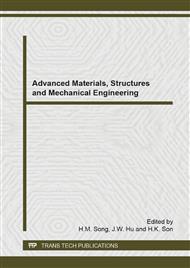p.651
p.656
p.661
p.668
p.672
p.677
p.683
p.688
p.693
3-Dimensional Porosity in Electroless Ni-YSZ Composite Coating
Abstract:
The paper discussed on a 3-dimensional porosity network in electroless nickel (Ni) - yttria stabilized zirconia (YSZ) composite coating. The important characteristics of Ni-YSZ composite such as high ceramic YSZ incorporation and adequate porosity up to 40 vol.% are used as the main parameters. The arrangement of the porosity that give a 3-dimensional porosity network within the composite was design in Pro-Engineer Wildfire 3.0 software. Three structures of 3-dimensional porosity network were used namely honeycomb, atomic sphere and rhombic dodecahedra. The calculated area and volume of one unit porosity, consequently the number of porosity were compared between the three structures. These were supported by the porosity in the electroless Ni-YSZ composite coating obtained experimentally. Two batches were produced, EN-YSZ and EN-YSZ-G representing samples without and with pore former respectively. The two batch samples were investigated and compared. The addition of graphite pore former was burnt out completely and left porosity in the coating.
Info:
Periodical:
Pages:
672-676
Citation:
Online since:
September 2014
Price:
Сopyright:
© 2014 Trans Tech Publications Ltd. All Rights Reserved
Share:
Citation:


